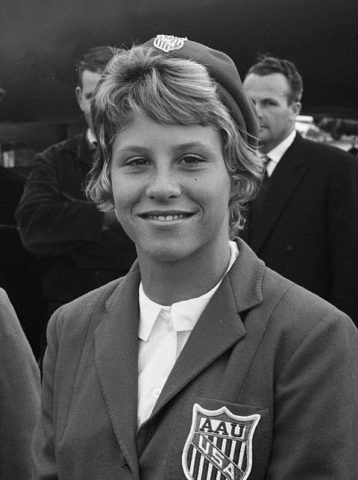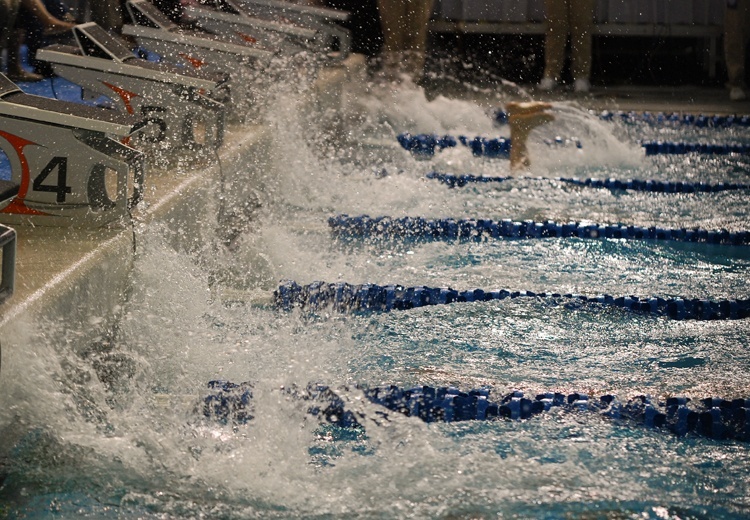Courtesy: Tom Slear
Don Shive had no inkling of becoming a trailblazer in swimming. He laughs at the mere thought of it. He had never swum in a race when he arrived at what is now Old Dominion University. He was there to occupy himself for a year as he tried for a second time to gain admittance to the United States Military Academy (aka West Point and Army). But the swim coach saw potential when Shive underwent a swim test given to all freshmen. Six months later he won a conference title in the 440-yard freestyle (more on that distance later).
Maybe I have some promise in this sport, Shive told himself. So he tried out for the swim team at Army and made it. His junior year he finished fifth in the 1650 at the Eastern Championships and set the school record.
But Shive’s moment in the sun came the next season, in 1964, during the dual meet against Navy. He swam the 500 free in the lane next to Navy’s top distance swimmer, Buddy Wier. Memories have faded significantly and archives have mostly disappeared over the intervening 56 years, so precision at this point is nearly impossible. The best estimate is that Wier’s time going into the race was nine seconds faster than Shive’s.
And yet, approaching the eighth turn, Shive found himself at Wier’s feet. Without a thought, he flipped the turn. Wier did an open turn. (Picture a one-handed butterfly or breaststroke turn.) After his push-off, Shive was at Wier’s shoulders.
“There was nothing planned,” Shive says, who until that 500 against Wier typically flipped the first seven turns and the last one. “It was a just a reaction to the moment.”
At the next turn, the same thing happened: Wier was leading by nearly a body length. Shive flipped. Wier opened. Shive caught him. The turn at the 250 was more of the same. When Shive turned his head to breath on his first stroke after the push-off, his field of vision was filled with excited teammates waving towels. Army had already secured the meet with multiple school records. Four cadets had swims that would earn All American, back when times from dual meets were considered. Nevertheless, the swim of the meet was going on now. Shive had cracked the code for staying with Wier. The question was whether he would keep flipping his turns.
“Nobody flipped turns”
Now, for some context: In all individual and relay freestyle races until the 1962-1963 season, college swimmers had to touch the wall at turns with one hand or the other. The rule made little sense. The hand touch forced swimmers to come close to the wall, making the flip itself slow and awkward. And the rule was difficult to enforce. Whether a swimmer actually touched was hard to determine. The only way to ensure compliance was to have an official looking straight down at each swimmer at every turn.
High schools didn’t want to accept the burden of all of those officials. Starting in 1956, their rule regarding freestyle turns was changed to say a foot touch was good enough. But colleges stuck with the hand touch, no doubt because it complied with FINA’s rules. The overwhelming majority of U.S. male Olympians were college swimmers. The prevailing mindset was to avoid practicing two types of turns, one for the college season the other for international meets.
The hand touch forced nearly all distance swimmers to ration their flip turns. The thinking was that in any race over 200 yards or meters, the flip with a hand touch gained little for the amount of energy expended. Doing an open turn with its extra breath was more beneficial. How this thinking played out varied widely. Marilyn Ramenofsky, a world record holder in the 400-meter freestyle and a silver medalist in the event at the 1964 Olympics, says she flipped every turn. Harrison Merrill, who as a 14-year-old finished sixth in the 1500-meter at the outdoor nationals in 1958 and later was an All American at North Carolina, says he flipped every turn.
However, in his book, Deep Water, four-time Olympic gold medalist in 1964, Don Schollander, wrote, “Nobody flipped turns, except possibly the last turn in the race, when you had only 50 meters to go and getting the jump at the wall could make a difference.” Still, on the way to winning the 400-meter free gold medal in Tokyo and setting a world record in the process, Schollander flipped three of his seven turns.
Sharon (Finnern) Rittenhouse flipped only two turns winning the 500 free and setting an American record at the 1963 indoor nationals. In the same meet, Donna de Varona did an open turn during the freestyle portion of her record-setting 200-yard IM.

Donna de Varona. Photo: Harry Pot, Wikipedia, Creative Commons.
And then there was Dawn Fraser, the Australian who was the first woman under a minute in the 100-meter free. As if to show you can have it both ways, she flipped her turn in the Olympic final in 1956 and won. She opened her turn in 1960 and again in 1964 and won both times.
Fussing Over Hand Touches
U.S. swimming mavens sorely wanted FINA to get rid of the hand touch but they faced stiff opposition. FINA gave little thought to America’s fixation with distances in yards and swims in short-course pools. In a clear message to American swimming, FINA announced in 1957 that it would no longer compile world records for short-course yards. U.S. swimmers have since been denied a bundle of international recognition, but FINA’s reasoning made sense. America was the only place that swam short-course yards to any extent, so it followed that those records were American not world.
(For years afterwards the U.S. maintained races of 220 and 440 yards, the rough equivalents of 200 and 400 meters, in the hope that FINA would see a connection between America’s yards and the world’s meters and reinstall world records for short-course yards. This meant finishing a 220-yard butterfly, for example, by swimming under flags strung across the 20-yard mark of the ninth lap. FINA was unmoved and finishes under flags became untenable with the onset of electronic timing, so the NCAA and the Amateur Athletic Union, which preceded USA Swimming as the sport’s national governing body, changed to 200 and 500 yards in 1963.)
FINA also didn’t get America’s fussing over hand touches on freestyle turns. The three other strokes required hand touches and besides, in long course, turns weren’t such a big deal.
The NCAA brought the matter to a head when it announced that hand touches on freestyle turns would no longer be required after the ’61-’62 season. But the change didn’t bring on an immediate adjustment in strategy. Coaches and swimmers continued to do a cost-benefit analysis. Even with the speed and shorter distance brought on by a flip turn without a hand touch, they worried both would be negated by the extra energy required, particularly in longer races. If you’re thinking turns back then were technique backwaters, you would be correct. Bill Mettler, a ’64 Olympian on the 800 free relay, remembers his club coach telling him to save energy by relaxing on the push-off. What’s more, goggles in competition were 10 years in the future. Without the aid of a hand touch, the possibility of misjudging the wall while trying to see through the water with naked eyes scared many swimmers into open turns.
A Significant Factor In Getting Faster
And so, as Shive flipped the 9th, then the 10th, and then the 11th turn in his race against Wier, a considerable number of swimmers and coaches at the time thought he was breaking new ground. Hard to say if that’s the case, just as it is hard to say who was the first to do a grab start, or more than a few underwater dolphin kicks after a start or turn.
Shive kept flipping, each time negating the advantage Wier gained by his swimming. Meanwhile, Wier did what he had always done. Despite the rule change the year before, he rarely flipped turns in a 500. He doesn’t remember flipping any turns in the race against Shive.
By the last turn, Shive was all emotion. He came off the wall and sprinted as if he were being chased by a shark. He won by nearly a body length with a time of 5:09.8, 16 seconds under his previous best. What wouldn’t pass for a warm-up time today was three seconds under the qualifying standard for the NCAA championships. (Wier had a good swim as well. He remembers he dropped his best time five seconds.)
In 1965, FINA relented and stopped requiring a hand touch on freestyle turns, thereby moving turns from something to tolerate to a significant factor in getting faster. Within a year, all of the swimmers in any higher-level meet, whether short-course yards or long-course meters, were flipping all of their freestyle turns. A year or two after that, they were flipping all of their turns in practice.
Shive, who went on to a 28-year career in the Army that included a tour in Vietnam as an infantry company commander and another combat tour during the first Gulf War, remembers several swimmers asking him during the Eastern Championships two weeks after the Navy meet whether he really did flip every turn in a 500. In some small way, he had moved the swimming needle forward.
Not bad for someone who didn’t start competing until after high school.

And for the same reasons that the hand touch turn was eliminated, first in freestyle, later in backstroke, it’s finally time to take the hand touch requirement out of of butterfly and breaststroke!
If you ever have the chance to talk to Don Shive about his experiences in swimming, combat (which he has plenty), or life in general do it! His ability to tell stories in such a self deprecating manner will leave you with a real sense of history and a smile on your face.
This story should be read by current swimmers if nothing more than to gain a sense of the history of how their sport developed.
As fascinating as the way Shive won is, I’m even more fascinated that someone would suggest, much less actually institute, stringing flags across the 20-yard mark of the final + 1 lap of a race in a short course yards pool to approximate a race in a meters pool. But on searching online about it, I discovered that the NFL, to conform to the international standard of meters, is lengthening the football field to 100 meters by painting lines at both of the 9.361 yard lines so that once a player crosses the end zone at 100 yards, he must then turn around and cross the 9.361 yard line to score a touchdown of 100 meters.
Great story!
So many fun facts contained within a single article. Thanks!